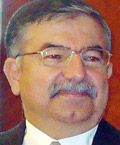The fact of not installing the cross on Saint Cross church caused all kinds of interpretations. They were speaking about the weight of the cross, dates of installation and the authority of making a decision. On the threshold of the service at the church we (journalists, who had left for Turkey with the invitation of Heinrich Buell and Hrant Dink foundations) met with the assistant to the minister of culture of Turkey Ismet Yuluz, who during the conversation with us, said, “The installation of the cross is impossible because our counterparts examined the history and found out that there had been no cross on Saint Cross church.” When we asked him surprisingly, where he had gotten that information, he unbreakably responded, “Our sources claim that. Besides that during the examination of 100-year-ol photos of Akhtamar Italian restorers found out that there was no cross on the church and that is the reason why they’d built a closed dome. There is no photo that would show a cross. If we try to place a cross we will damage the building. In the architectural aspect it’s impossible. It will make us conduct more restoration works. We also took into account the climate as in Van winters are cold and snowy. In the event of snow blizzard the cross will fall down.” Yuluz also mentioned that due to the events of 1915 people suffered more than buildings. History, in general, implies a quite interesting feature. It may stop at any point and be launched from ground zero. Afterwards the Turkish diplomat-advisor advises not to go too deep in the history. “In Turkey there are numerous cultural centers. There are many mosques, which are being annihilated and we are not able to restore those. I don’t mean to say that for the Turkish government the priority is the restoration of mosques rather than Christian churches. I am trying to say that we are doing all that one by one,” noted the statesman of the Turkish culture sector. He also added that they were expecting a responsive step from Yerevan. To the question what step he refers to Yuluz answered, “I want your experts restore the Turkish legacy in Armenia.” This statesman also mentioned that if their ministry decides that various ceremonies, events and films or video series are not useful they ban those. Lately, for example, they closed youtube.com internet website, because it contained irrelevant scenes about Ataturk. Perhaps for their own reason and use they didn’t place a cross on the dome. “Our steps are reconciled with the Armenian Patriarch of Polis,” cordially smiled Ismet Yuluz. The same concern was delivered by the director of the museum of Akhtamar Vaghinak Sargafagyan. “Our goal is to become owners of our property step by step. It is not right to hinder us. Our Patriarch has long ago had the wish to organize cultural festivals and holidays on Akhtamar island. And now we are very close to realizing this dream. Although currently the Saint Cross church is without a cross, although we have an opportunity to annually deliver one service but let us not forget that one is better than zero.” The Armenian clergymen of Polis were saying that they are finding the decision of the Catholicos to boycott the service harmful because many Diaspora representatives obeyed this decision and didn’t visit Van. Indeed, the installation of the cross was quite exaggerated, which diminished the importance of other issues. The most important of those is the absence of the demander’s attitude. Moreover, the absence of this attitude hinders the communication at various levels. And it turns out that various politicians and experts of different calibers and even clergymen avoid opening the sealed “Pandora Box.”

